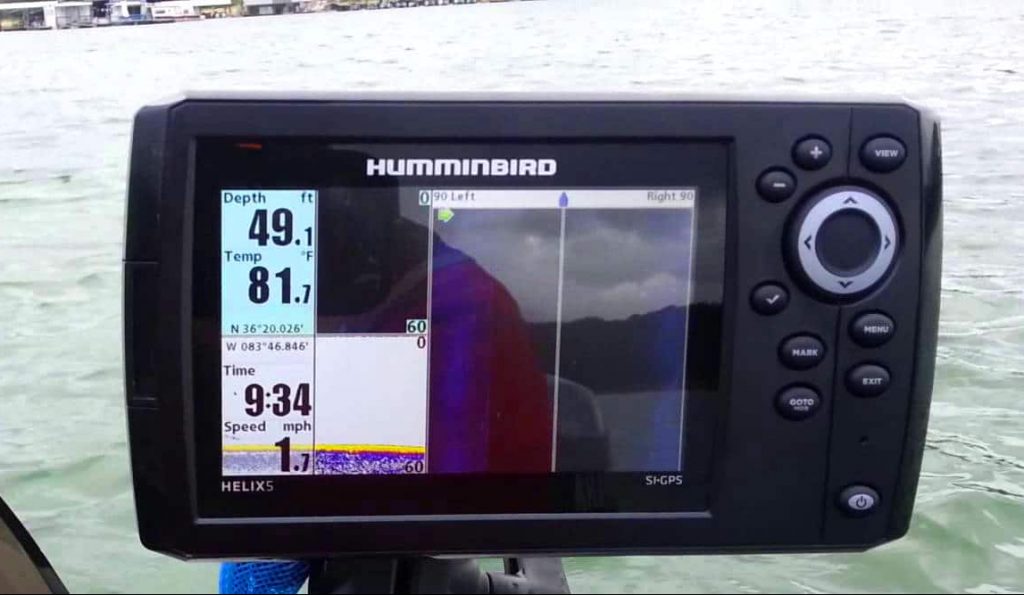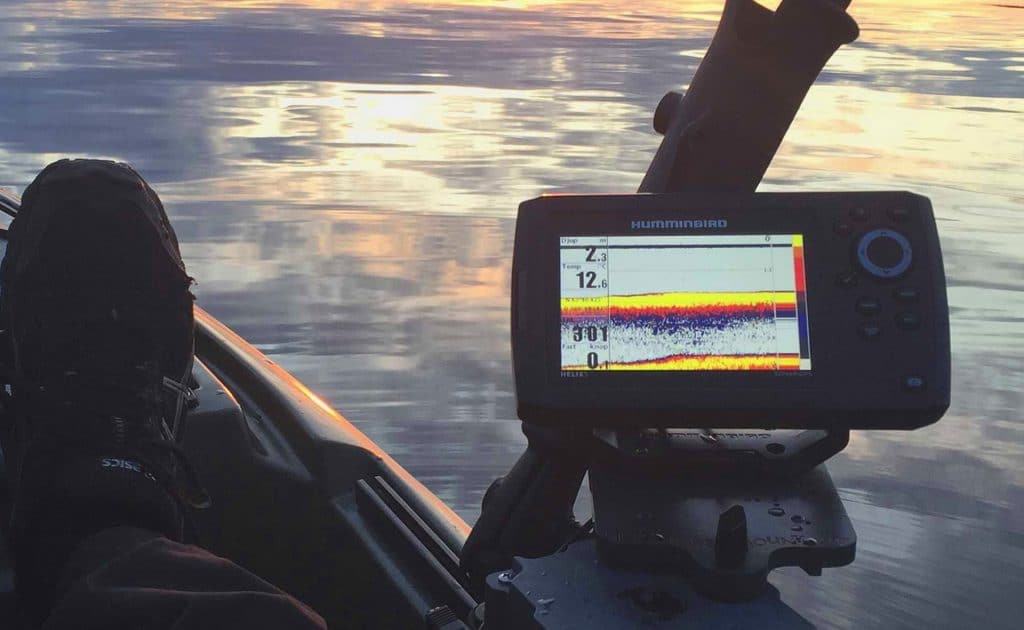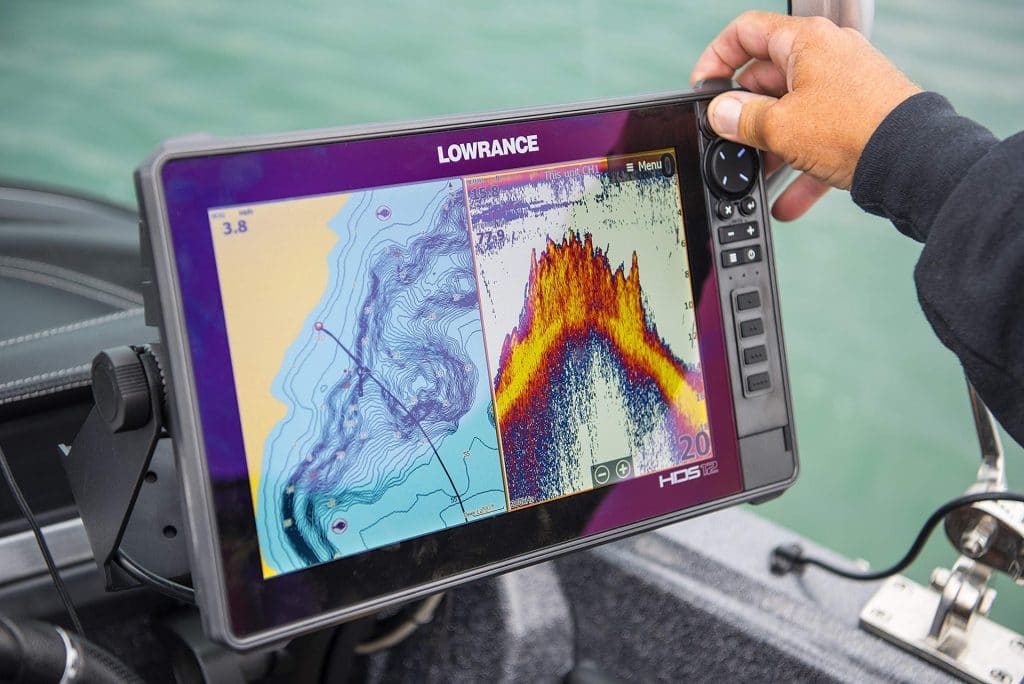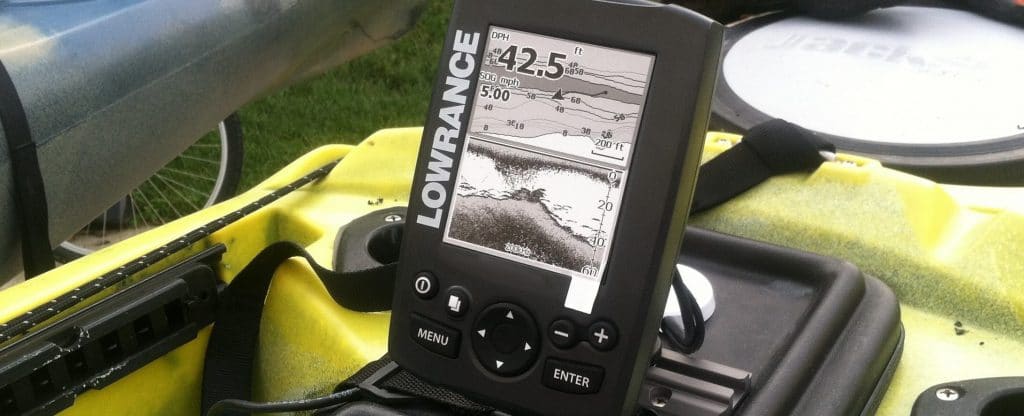

Technology has changed many aspects of our lives. If you love fishing, there are now products available you might not have dreamt of years ago. A fish finder can help you to locate schools of fish underwater. Choose the right model and your fishing trips will be far more fruitful! In this article, we’ve reviewed the best fish finder under $300 to help you to ensure you can find the best product in your price range.
Our team has looked at the features needed for a fish finder to be called one of the best. The features we’ve rated products on are based upon the quality of the display, the type of sonar used, the maximum scanning depth, and the GPS functionality on offer, as well as whether they have MicroSD slots and more. Our editor’s choice is the Humminbird 410210-1 Helix 5 G2 Series, which is an example of a product with exceptional features across the board.
Our researchers spent weeks gathering the top information to provide you with the best choices out there under $300. Sources include manufacturer information as well as reviews from fishing fanatics. We’ve presented our research as a simple overview table with product nominations, as well as in-depth reviews to let you read exactly why we’ve selected them. There is also a buying guide where we discuss the features of the top fish finders and which of them may be most important to your own specific needs.
Extra features: precision GPS chart plotting with Anima cartography, AutoChart live
Our editor’s choice, the Humminbird 410210-1 Helix 5 G2 Series, is a great example of a product with extremely professional features in spite of not costing a huge amount.
It offers side-to-side as well as down imaging to allow you to clearly see what is going on around you and ensure fish have nowhere to hide.
The CHIRP digital sonar that is included has the ability to capture detail that other types of this sonar tech won’t show you.
It is compatible with a micro-SD card, so you can create and save maps of your favorite fishing spots and use them at a later date. You don’t need to do this if you don’t want to, as the Humminbird basemap comes included with the product to get you started, so you can fish straight away once receiving this product.
The live, real-time maps are created with software called AutoChart Live, which is pretty reliable and the depth can go down to 1500 feet – enough even for deep fishing spots!
The excellent GPS is a big upgrade, especially if you’re coming from a model that doesn’t offer GPS.
One criticism is the fact that the clips which are used to attach this to the boat or kayak could be of better quality. But all in all, for the price, this is a fantastic choice!
Extra features: casts up to 330ft; generates its own Wi-Fi signal to sync with smartphone (compatible with iOS and Android); ice fishing mode – handles temperatures up to -4°F
The Deeper PRO+ is best castable fish finder you can find under $300, and is a good option for fishermen who like to stay inland. It casts out up to 330 feet and then creates maps up to 260 feet down in the lakes. It is great for shore fishing, though not as great for lakes.
It has a built-in GPS so it can create map images, but also gives you a lake book, which allows you to manage and analyze maps that have already been created. This works with your smartphone to make use even easier.
The Deeper App it connects to can be used on both iOS and Android and is updated monthly with new information and maps. This app works to show you vegetation, the structure of what is underwater, temperature and, of course, the fish locations and size.
It uses wide beam and narrow beam sonars to create the scans.
Though not suitable for taking out on kayaking trips or the like, and not great with deep waters, this is a really convenient casting app from the shore.
Extra features: built-in flasher; IPX7 water rating
The Garmin Striker 4 has some really impressive features when you consider the price, which is why we’ve named it our best budget pick when it comes to fish finders. So, if you’re looking to spend the minimum amount possible for a decent model of fish finder, the Striker 4 might be for you.
Though it is much cheaper, it does have the same CHIRP ClearVü technology that more expensive Garmin’s have for good quality sonar imaging.
The waypoint map is really simple to view and navigate. You can see locations like stumps or docks within, and in freshwater this can scan up to 1,600 feet deep. In saltwater, it is a 750-feet potential depth.
The display of the data shown on this fish finder is different to most of the other choices on this list as it is a vertical screen. It shows sonar in the flasher format that you may be used to if you’ve used other affordable fish finders.
As with most products made by Garmin, you can rest assured that the GPS is fantastic quality.
This isn’t perfect, and there are some sacrifices at this price point – but if you just want a basic option and aren’t too worried about all of the advanced features, this is a top cheap fish finder.
Extra features: features side view; SplitShot transducer; preloaded C-MAP US inland lake maps
If you are looking for a product that is extremely easy to control and use, then the Lowrance HOOK2 5 could be a wise choice. It has a large 7-inch display with a great image, which makes it really easy to see what is going on. On top of this, it has simple button controls with an interface you can get to grips with in a matter of minutes.
This is GPS-enabled and you also have the option to expand it with Micro SD cards.
Like many of the fish finders under 300 dollars, it does come with a CHIRP sonar. This is an upgraded version of sonar that can offer twice the coverage some of the other options that Lowrance have.
As well as being easy to use in terms of interface, it comes with all you need to mount on the hull, transom, or even on the motor.
It has straight down sonar views and also fish arch views within the display.
Inbuilt are C-Map lake maps, with over 3000 lakes as standard, with up to 1-foot contour accuracy. There is coverage of another 9,000 lakes, too. These are all pre-loaded onto the device.
Extra features: features fish alarms, depth alarms, and Humminbird’s Fish ID+ system
This is the most affordable option from Humminbird, one of the best manufacturers of fish finders on the market. It only has down imaging as opposed to side imaging, but the features it includes are pretty exceptional.
It has Fish ID system which determines the location and depth of fish in the water, and you can set up fish alarms when you are out fishing, making it great for use on a boat. It also has a great quality Dual Beam sonar. You can actually choose between narrow or wide beams for the best detail and the coverage area you need.
Though it doesn’t have side imaging, the down imaging works very well and allows you to see any feature in pretty good detail. Timber, rocks and other structures below the surface of the water can be seen in detail.
Mounting is easy, and the mount it comes with has a clever swiveling function so you can look from a different angle if you wish.
This model doesn’t have GPS, so if you are looking for the best GPS fish finder under $300 then you will need to look at the other options on our list.
Extra features: IPX7 water rating; preloaded with U.S. BlueChart g2 charts; comes with Quickdraw Contours custom HD map creation software
Garmin is a brand you have probably heard of. They manufacture a huge number of products in the GPS market but also make some brilliant fish finders.
The Garmin echoMAP features both the traditional CHIRP sonar, as well as Garmin’s CHIRP “ClearVü”, allowing for a high quality picture with great target separation. This high-frequency sonar gives an impressive level of detail and images that are verging on photographic quality. The CHIRP sonar is the most reliable you are likely to find at this price.
The inbuilt maps include BlueChart G2, and these cover the USA, but you can purchase Canada LakeVu HD which covers the Canadian lakes too.
There is a built-in 5Hz GPS which can update your position within the water up to 5 times a second for extra accuracy and to allow you to mark waypoints with precision.
Quickdraw software is included and allows you to make your own maps of routes you often fish.
One criticism some people have had is the fact that this isn’t always the easiest to set waypoints and interact with when out on the water. There are quite a few menus which you have to be able to get through – and when you’re in a boat or kayak, this isn’t that easy to do.
As well as reviewing a load of the top options on the market that fit within a $300 budget, we’ve created a buying guide below to help you to establish what features are most important to you. If you have never owned a fish finder before then there can be a lot to get your head around in terms of features, and we’ve tried to make this simpler. You should consider the environment you will be using it in too, and whether you need the a fish finder for a small boat or kayak, or maybe you need a model for larger fishing trips.
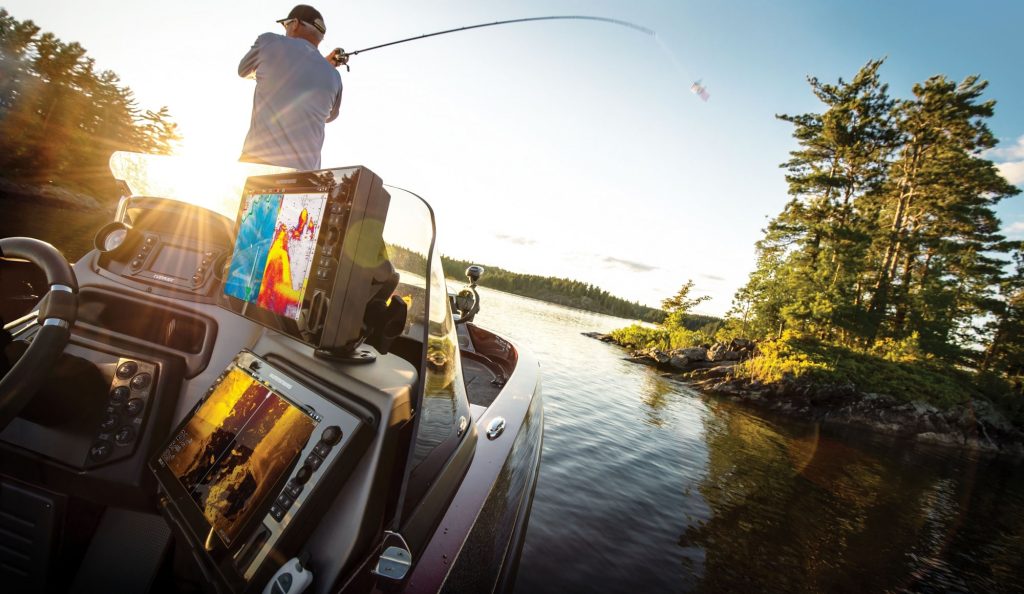
Fish finders have had a lot of advancements in recent years and you can find some options that don’t cost too much, which is why we’ve been able to compile a list of the best fish finders under $300 and reviews of these products.
Fish finders have come a long way, and can even help you to work out new lakes and where the fish might be, or even track down individual species of fish!
The following features are those which we have identified as being some of the most important when choosing a fish finder, you should work out what these features mean and why they may be important to you before you make any purchase.
The display is the part where we actually see the data that the fish finder is providing us with. The way data is displayed can vary, and so can the display itself. Some of the displays are colored, some are vertical, some are horizontal. This is a case of making sure it is big enough to display all of the info you will need. If you can get a display with a lot of colors and imaging which replicates virtually photographic quality, this is a real bonus.
There are different kinds of sonar and some are designed to provide more detailed and thorough results. The CHIRP system is probably the most effective that is likely to be included in the options of fish finder under $300. Our editor’s choice, the Humminbird 410210-1 Helix 5 G2 Series, is an example of a fish finder using this type of sonar. Other products such as the Deeper PRO+ use a dual beam sonar.
This is simply the depth to which the sonar can work, and that the mapping facilities within the fish finder can be effective. Some products can scan down as far as 1,600 feet. The Garmin Striker 4, our budget pick, is an example of a fish finder that can work this deep down. It is likely to vary for freshwater and saltwater, so ensure you check the capabilities for both. Saltwater usually only works to shallower depths.
A MicroSD card allows you to expand your fish finder, you can add more maps or save the data from trips and GPS information that you have collected when out on the lakes. The ability to use these cards also means you can get more up-to-date information onto your fish finder with ease.
A product such as this, which will be used near water, needs to have some level of water resistance, or ideally be waterproof. The water rating will show just how well this can handle the water, and whether you need to worry about a few splashes of water getting onto your device.
As well as the dimensions of the screen, you should check the overall dimensions.
You need a balance between something that is big enough to see, but also relatively compact.
Any electronic product worth its salt will offer some form of warranty! Most of the products on this list have some sort of warranty and buyer protection to ensure that if you do end up with a defective product, you can get it repaired or replaced. Check the warranty on offer from the manufacturer before you make your purchase.
Fish finders are gaining more and more high-tech features. This is due to the fact that we live in a world of technological advancements. Many of the models on the list are building in more advanced extra features. Some of these include the ability to connect your device to Wi-Fi, which can allow you to update and get the latest mapping and data on your fish finder. Some of the top fish finders out there work in conjunction with your smartphone, too, so you can review your data on smartphone whether you use iOS or Android – this is true for the Deeper PRO+ fish finder.
Other extra features don’t have to be so high-tech. For instance, the Humminbird 410160-1 PiranhaMAX 4.3 DI has an excellent swivel mount, which is a big plus point and can allow you to change the angle of the fish finder when you’re using it in your boat or kayak.
The Humminbird 410210-1 Helix 5 G2 Series deserves to be our editor’s choice and has a rating of 9.8/10. We particularly liked the fact that this product has such brilliant, reliable CHIRP sonar and can work up to 1500 feet deep. It also has expandable functionality using micro SD.
The Garmin echoMAP CHIRP is similar in terms of quality, and is rated 9.6. The HD mapping software included is a real bonus and allows you to set markers and create custom maps of your fishing locations.
The third highest rated product at 9.3/10 is the Deeper PRO+ Smart Sonar, and this is the only product on our quest to find the best fish finder under $300 that is a castable model. It can work at up to -4 degrees Fahrenheit and is great for inshore fishing.
